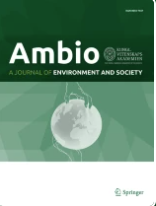- Department:(Dept. 1) Ecohydrology and Biogeochemistry
Unveiling nitrate origins in semiarid aquifers: A comparative analysis of Bayesian isotope mixing models using nitrate and boron isotopes and a Positive Matrix Factorization model
The authors identified the dominant sources of nitrate pollution and biogeochemical transformations in the semiarid region of the Meoqui-Delicias aquifer, Mexico, where the uncontrolled use of chemical fertilizers and manure lead to excessive nutrient input resulting in deterioration of groundwater quality. This provides an evidence base for policy-making to protect drinking water quality.
Linking terrestrial biogeochemical processes and water ages to catchment water quality: A new Damköhler analysis based on coupled modeling of isotope tracers and nitrate dynamics
Catchment-scale nitrate dynamics involve complex coupling of hydrological transport and biogeochemical transformations, imposing challenges for source control of diffuse pollution. Coupled modeling of isotope tracers and nitrate dynamics revealed that upland arable areas impose pollution risks under drought while the river-connected lowlands are processing hotspots and more resilient to drought.
Temperatures and hypolimnetic oxygen in German lakes: Observations, future trends and adaptation potential
A study of oxygen and temperature trends in 46 German lakes showed that temperatures have risen mainly at the surface, but not in the deep water. This led to increased stratification and lower oxygen concentrations. Scenarios showed that these effects of climate change on oxygen content could be compensated by reducing nutrients.
Flow Rate and Kinetics of Trace Organic Contaminants Removal in Black Carbon-Amended Engineered Media Filters for Improved Stormwater Runoff Treatment
Urban stormwater runoff is an untapped source of freshwater for many water-scarce regions, but improved stormwater treatment is needed for safe use and to protect human and aquatic health. This work provides insights into the kinetic limitations of contaminant removal within biochar and regenerated activated carbon filters and discusses implications for stormwater filter design and operation.
Long-term drought effects on landscape water storage and recovery under contrasting landuses
Process-based, tracer-aided ecohydrological modelling and ML were combined to estimate the effects of long-term drought on water fluxes/storage in the Spree catchment. The recent major droughts resulted in declines in groundwater recharge (>40 %), evapotranspiration (up to 16 %) and soil moisture (up to 6 %). Groundwater levels may not recover in 15 years if precipitation anomalies persist.
Hydroclimatic non-stationarity drives stream hydrochemistry dynamics through controls on catchment connectivity and water ages
Long-term water chemistry and isotope data were integrated to investigate hydrological function and water ages in the Scottish Girnock Burn catchment with an Atlantic Salmon population. Changing climatic conditions and stream flow responses continue to cause changes in water quality and ecosystem services with an increase in low flows, derived from older groundwater with more alkaline chemistry.
Six decades of ecohydrological research connecting landscapes and riverscapes in the Girnock Burn, Scotland: Atlantic salmon population and habitat dynamics in a changing world
Six decades of ecological monitoring provided the science needed to preserve Atlantic salmon. The unique long-term data revealed quantitative changes in the return rates, distribution, size, growth and age of salmon, increasing understanding on how ecosystems are changing in response to a warming climate.
Quantifying intra- and inter-annual dynamics of river-floodplain connectivity and wetland inundation with remote sensing and wavelet analysis
The authors used remote sensing data and wavelet analysis to quantify dynamics in floodplain inundation and riverfloodplain connectivity in the Lower Oder Valley National Park. They found marked inter-annual variation of wetland inundation. Heavy precipitation caused summer flooding in only one polder. This information is important for managing flows and sustaining valuable wetland habitats.
Assessing impacts of alternative land use strategies on water partitioning, storage and ages in drought-sensitive lowlandcatchments using tracer-aided ecohydrological modelling
The authors used advanced process-based ecohydrological modelling to assess the effects of realistic land use scenarios for the Berlin/Brandenburg region on water flux and storage dynamics. Replacing conifer forests with uneven-aged mixed forests with younger, broad-leaved trees had the greatest potential for reducing evapotranspiration and increasing groundwater recharge
Hydrological model skills change with drought severity; insights from multi-variable evaluation
The study investigated the ability of the Continuum hydrological model in simulating the water cycle in the Po river basin (Italy) during droughts of increasing severity. The simulation of streamflow during the severe 2022 drought was characterized by comparatively lower performances than during moderate events, most likely due to challenges in representing high human influences via irrigation.





